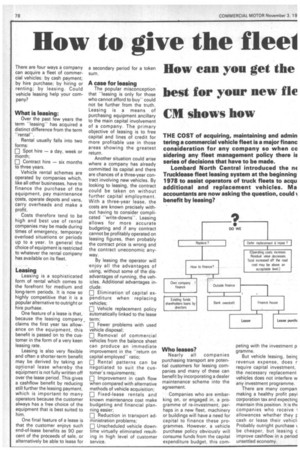How to give the Heel
Page 80

If you've noticed an error in this article please click here to report it so we can fix it.
How can you get the best for your new fie CM shows how
There are four ways a company can acquire a fleet of commercial vehicles. by cash payment; by hire purchase: by hiring or renting; by leasing. Could vehicle leasing help your company?
What is leasing: Over the past few years the term "'leasing" has acquired a distinct difference from the term _rental".
Rental usually falls into two to E Spot hire — a day, week or month; O Contract hire — six months to three years.
Vehicle rental schemes are operated by companies which, like all other businesses, have to finance the purchase of the equipment, pay maintenance costs, operate depots and vans, carry overheads and make a profit.
Costs therefore tend to be high and best use of rental companies may be made during times of emergency, temporary overload situations or periods up to a year. In general the choice of equipment is restricted to whatever the rental company has available on its fleet.
Leasing
Leasing is a sophisticated form of rental which comes to the forefront for medium and long-term periods. It is now so highly competitive that it is a popular alternative to outright or hire purhase.
One feature of a lease is that, because the leasing company_ claims the first year tax allowance on the equipment, this benefit is passed On to the customer in the form of a very keen leasing rate.
Leasing is also very flexible and often a shorter-term benefit may be derived by taking an optional lease whereby the equipment is not fully written off over the lease period. This gives a cashflow benefit by reducing still further the leasing payment, which is important to many operators because the customer always has a free choice of the equipment that is best suited to him.
One final feature of a lease is that the customer enjoys such end-of-lease benefits as 90 per cent of the proceeds of sale, or alternatively be able to lease for
A case for leasing
The popular misconception that "'leasing is only for those who cannot afford to buy" could not be further from the truth. Leasing is a means of purchasing equipment ancillary to the main capital involvement of a company. The primary objective of leasing is to free capital and lines of credit for more profitable use in those areas showing the greatest return.
Another situation could arise where a company has already committed its capital and there are chances of a three-year contract involving new vehicles. By looking to leasing, the contract could be taken on without further capital employment. With a three-year lease, the costs are known precisely without having to consider complicated "write-downs". Leasing allows for more accurate budgeting and if any contract cannot be profitably operated on leasing figures, then probably the contract price is wrong and the contract uneconomic anyway.
By leasing the operator will enjoy all the advantages of using, without some of the disadvantages of running, the vehicles. Additional advantages include: O Elimination of capital expenditure when replacing vehicles; 0 Vehicle replacement policy automatically linked to the lease term; 0 Fewer problems with used vehicle disposal; O Removal of commercial vehicles from the balance sheet can produce an immediate improvement in the "return on capital employed" ratio; O Rental patterns can be negotiated to suit the customer's requirements; • Improvement in cash flow when compared with alternative methods of vehicle acquisition; O Fixed-lease rentals and known maintenance cost make budgeting and financial planning easier; 0 Reduction in transport administration problems; O Unscheduled vehicle downtime virtually eliminated resulting in high level of customer service.




























































































































